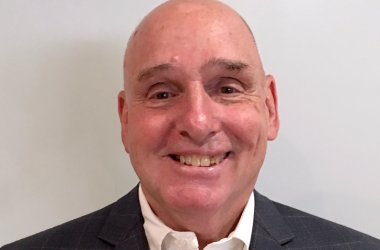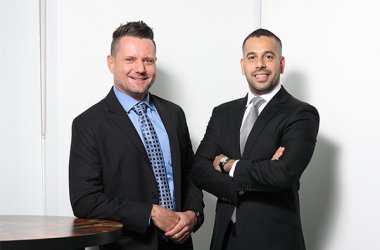
Top notch speakers at the Reseller Conference covered a wide gamut of channel topics including upcoming technology trends, value addition, vendor-partner relationships, cash flow and social marketing
On 12 June, Reseller Middle East kicked off its first conference directed at the reseller community. The conference was a day-long, single track event, held at Westin Dubai, UAE. The highlights of the conference were intended to be the wide range of channel issues tackled by a high-level team of experienced industry leaders selected from vendors, distributors and consultants. The presentation content of each topic was set to appeal at an operational level rather than at a conceptual level.
The conference was kicked off by a short welcome address by Reseller’s senior editor Arun Shankar, after which the key note speaker was invited to the stage
The keynote address for the conference was presented by Nassir Nauthoa, General Manager, GCC, Intel Corporation. There were a number of important highlights in the presentation. Nauthoa drew the attention of the audience to the increasing purchasing power of the emerging markets. The index used to track the changes in purchasing power of the markets is the number of weeks of income required to buy an average priced consumer laptop.
In 1994, it required 151 weeks of income to buy a laptop in the emerging markers versus 6 weeks of income in developed markets. In 2010, the same comparison has changed to 12 weeks of income in emerging markets versus 1 week of income for developed markets. This shows that a vast segment of population in the emerging markets is moving towards affordable ownership of a PC or a laptop.
Today, one billion people own a PC device, but 2.2 billion people can afford a PC and have not invested in such a device. A further 3.5 billion people still cannot afford a PC device.
The engine of the emerging markets is so compelling that by end 2011 and early 2012, the total number of PCs shipped to the emerging markets will overtake the developed markets.
Nauthoa also pointed out the changing nature of the personal computing device. It is not just PCs and laptops which the growing segment of population will use for computing. By 2015, only 56% of mobile traffic will be generated by laptops. Rest of the traffic will be generated from smart phones, home gateways and others. The forms of computing devices are changing and the all-in-one PC screen, ultra-book, smart TV, tablet and netbook are all possible variants of today’s desktop PC.
However is the PC dead? Nauthoa indicated that the death knell of the PC was announced in 1997 with the network computer; again in 1999 with internet appliances; in 2005 with the cloud; in 2007 with the smart phone; in 2009 with the netbook; and in 2010 with the tablet. In 2010 there were one million devices shipped per day. All forecast indicate that by 2015 there will be two million shipped per day. So the PC is not dead!
Intel’s vision of the future: by 2020 there will four billion connected people, 31 billion connected devices and 25 million applications. The key drivers for computing devices will remain performance, security and connectivity.
After Nathuoa’s visionary address, there was a round table discussion on the growth dynamics across the Middle East. The participants were jointly made up of speakers from the Reseller Conference and some special invitees. The speakers of the conference who sat on the panel included Nassir Nauthoa, Intel Corporation; Meera Kaul, Optimus Technology and Telecommunications and Hesham Tantawi, Asbis.
The special invitees included Sukant Mishra, Managing Director, Octagon International; Prateek Dayal, Channels & Alliances Director, Xerox Emirates; KS Parag, Managing Director, FVC; Parag Saxena, Head of Sales, Redington Value; Patrick Mulligan, General Manager, Emitac Distribution. Reseller Middle East’s senior editor Arun Shankar, moderated the discussions.
The next pair of speakers after the panel discussion was Vasudevan KS, Managing Director, Satvik and Amir Sohrabi, Regional Alliances & Partner Development Manager Middle East, SAS. Both addressed the issue of analysis to aid in channel sales. The focus was on interpreting market dynamics through the eyes of data; the shifting trends in the market; the changing business priorities and an introduction to marketing, risk and operation analytics.
The next speaker was Meera Kaul, Managing Director, Optimus Technology and Telecommunications. Her theme was around possible value addition by a distributor in the channel market. With channel sales accounting for 60-80% of IT vendor sales, the role of a channel player is vital in today’s market. A channel player is faced with the task of differentiation from other players and the increasing demand from customers, but is probably the only one who has a deep understanding of a customer’s complex ecosystem.
Kaul presented how a channel player can leverage on this fact and be better prepared to address tomorrow today. For a vendor, value and volume are like birds of two different colours. “Channel has become an extension of the vendor”, she summarised.
An important topic before lunch was counterfeit products in channels by Ernest Azzam, Business Manager, Laser and Enterprise Solutions, HP. Azzam pointed out that the current market size for counterfeit products is $775 billion and will cross $ Trillion in 2015. The number of jobs lost because of this illegal trade in G20 countries alone is two and half million. Usage of counterfeit products is an operational disconnect for HP since it creates void warranty claims when toners leak inside the printer.
Globally in the last year HP conducted 3,000 channel audits to check for trading in counterfeit. Any incidence of illegal trading leads to termination of business partner status. According to Azzam, a starting point for corrective measures is an end-user corporate policy that avoids purchase of counterfeit products. 70% of UAE companies have no such anti-counterfeit policy in place.
After lunch, the audience was presented with a business focussed and well directed presentation by Hemayun Bazaz, Channel Manager, HP Networking. Bazaz explored in straight-forward language disconnects that sometime exist between vendors and reseller partners in the channel space.
Partners complain that vendor programs are complicated in terms of rebates, available marketing support and specialisation training programs. Vendors complain that partners do not make an effort to understand their programs and miss out on financial returns. Bazaz stressed that the solution lay at the half-way mark, both sides making an effort to meet mid-way.
The next presentation was on cash flow management by Vishnu Deuskar, Managing Director, Salvus Strategic Advisors. Deuskar presented a sound operational plan to avoid cash flow crisis. Companies should have a daily, weekly, monthly, quarterly cash flow forecast based on probabilities with worst case scenarios in-built separately and highlighted.
This should be sent to decision makers on a daily basis to avoid emergency plans being created like private funding at high interest rates. Another possible area of financial loss by traders in the re-export business is in currency mismatches, when incorrect rates are used in quotations and invoices.
Continuing on the economical perspective of the market, the next topic was on the dynamics of exports out of UAE. Dr Ashraf Ali Mahate, Head of Export Market Intelligence talked about the need to export out of UAE in the face of growing entry of low cost players and development of production scale. Dubai is ideally suited to be a hub for exports. All countries can be reached by shipping within 30 days and by air within 24 hours.
Exports have been consistently growing at close to 30% for the last five years. However Mahate warned that an exhaustive due diligence of a planned export strategy should be completed before project roll out is initiated. The due diligence should cover target countries, IP protection, distribution partners, and marketing plans amongst others.
The next topic addressed by Hesham Tantawi, Vice President, Asbis was on bottlenecks in the channel. Hesham chose to focus on explaining the drivers of sales in the current market, types of pricing, the relation between value and price, and some key parameters of profits. On pricing Tantawi differentiated between market based and cost based pricing. He gave an empirical formula for the calculation of GPROCA.
An interesting numerical example showed that a 10% improvement in lead generation and conversion process actually yields 46% increase in sales and 61% increase in profits.
The last session of the day was addressed by John Andrews, Director of Marketing MEA and APAC, Computerlinks, on the subject of zero cost marketing and the power of social communications. Andrews started by comparing the costs of launching a brand over the last ten years. In 2001, the launch cost of Microsoft XP brand was $0.7 billion, and in comparison the Coke advertising budget in 2009 was $3.6 billion. In addition to the five Ps of marketing, Andrew added process and physical evidence to bring it to seven Ps.
For zero cost marketing, Andrews listed electronic mailing, e-newsletters, social media and press opportunities. Andrew pointed out that although his company maintained a social media team to monitor customer feedback, the team was still posted as a marketing expense without a tangible return on investment. His key takeaway, “people are your biggest marketing asset, more powerful than any social media.”
The Reseller Conference concluded with a vigorous question and answer session directed at a panel made up of speakers again. Speakers participating in the end of day session included Meera Kaul, Hesham Tantawi and John Andrews.
==================
Panel discussion: Middle East growth wave
Participants
Nassir Nauthoa, General Manager, GCC, Intel Corporation
Meera Kaul, Managing Director, Optimus Technology and Telecommunications
Hesham Tantawi, Vice President, Asbis
Sukant Mishra, Managing Director, Octagon International
Prateek Dayal, Channels & Alliances Director, Xerox Emirates
KS Parag, Managing Director, FVC
Parag Saxena, Head of Sales, Redington Value
Patrick Mulligan, General Manager, Emitac Distribution
Arun Shankar, Senior Editor, Reseller Middle East (moderator)
The leading question to the panel was to summarize their assessment of the growth dynamics in the region. From a technology point of view, Nauthoa indicated that the multiple technology life cycles had not created any cyclical period of sales in the Middle East and as per the technology dynamics there should be good growth in the region. But where is it, remains the big question?
Tantawi of Asbis, who had just returned from a trip to Egypt indicated that current business was about 80% of the expected value. And overall growth across North Africa was expected to be flat by the end of the year. Kaul of Optimus, indicated that different regions are at different points of the innovation curve. For some it was cloud and for others it was infrastructure. Overall an upswing was expected.
Parag of FVC, which operates in MEA countries, indicated that it was important to understand customer pain areas. Once that has been achieved business needs can be addressed and market growth can happen. Xerox’s Dayal mentioned that revenues across the region have been consistent. The company changed its channel structure over the last few years and has seen significant growth at the lower end of its product range.
For Octagon which uses Kenya as its trading hub, the growth from Africa is in double digits and is looking “very green at present”. Inspite of the volatility in the region, Mishra indicated that overall Middle East business was stable. For Redington which operates in six African and six Gulf countries, the business from Africa has been good and the momentum of sales is picking up driven by Saudi along with Kuwait, Bahrain, Qatar and Oman. However, each market has different demands according to Saxena.
Emitac’s Mulligan pointed out the inherent risks still prevailing across the region. “I think we’re in really dangerous hands. There’s a lot of volatility in the market and significant financial exposure in places like Bahrain and Libya. So markets are unpredictable. The question is: how do we balance growth and danger?”
The next round of questions was on managing credit risks through channel partners. Tantawi pointed out that Asbis always monitors every channel partners risk as if it were its own. It always monitors the sales of each of its partners and understands their business as well. Octagon’s Mishra stated that there have been substantial changes in the way the channel is working, but the challenge still remains on how to manage credit risk?
For Redington Value, the problem of credit risk was addressed seven years ago when they brought in credit insurance. However the distributor carefully monitors the behaviour of its reseller channel partners. “It’s the classic problem of distribution, sell to end users and the risk is low. Sell to resellers and the risk is high,” remarked Saxena. For FVC, it manages risk based on the vertical market segment where it operates. “For example there is always a long payment cycle in the government sector”, said Parag.
In terms of market development the panel was asked about their changing business models. Intel’s Nauthoa was of the opinion, “we need to ask our channel customers what is the purpose of their business? This will deliver focus. Then match the customer with the supply chain.”
For players that operate in Africa, like Octagon, the weak infrastructure would be a constraint in limiting roll out of connected consumer devices. “Africa is a generation behind. Technology is available but cannot be used because of a lack of infrastructure,” said Mishra.
For Optimus, operating across vast geographies from Levant, West Asia, North Africa and the Gulf, “every country has its own growth curve and technology is taken up differently in different territories. For example, the UAE is all about cloud services but that is not being spoken of at all in Saudi,” said Kaul. Another survival technique for Optimus is to be close to the customer. “We realised our value lies in adding value to the whole chain from vendor to customer. So we have multiple points of contact: each one adds revenue and adds value.”
For Redington Value, their biggest value-add opportunity in the near future lies in the growing requirement for security. For FVC another value-add player, the challenge is always to keep asking “where is the big value? We need to add value or die,” said Parag. Another key differentiator that FVC adopts is to look at cutting-edge technology from the point of view of the customer and ROI.
For Xerox, it is developing products as markets expand. While the corporate end user is moving towards the cloud, “printing is still at the user point. And that is very good for us”, said Dayal.
Innovation is an important factor for Emitac and adds to the bottom line. In order to cope with the market challenges, “certainly, things need to be done radically differently tomorrow”, said Mulligan.
==================





